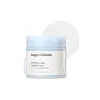What's inside
What's inside
 Key Ingredients
Key Ingredients

 Benefits
Benefits

 Concerns
Concerns

 Ingredients Side-by-side
Ingredients Side-by-side

Water
Skin ConditioningGlycerin
HumectantDipropylene Glycol
HumectantGlyceryl Glucoside
Humectant1,2-Hexanediol
Skin ConditioningAllantoin
Skin ConditioningEthylhexylglycerin
Skin ConditioningC12-14 Pareth-12
EmulsifyingBetaine
HumectantCaprylyl Glycol
EmollientArtemisia Princeps Leaf Water
MaskingButylene Glycol
HumectantCentella Asiatica Extract
CleansingMelaleuca Alternifolia Leaf Extract
PerfumingCarbomer
Emulsion StabilisingSodium Citrate
BufferingDisodium EDTA
Gluconolactone
Skin ConditioningSalicylic Acid
MaskingTromethamine
BufferingGlucose
HumectantAniba Rosodora Wood Oil
AstringentSodium Hyaluronate
HumectantWater, Glycerin, Dipropylene Glycol, Glyceryl Glucoside, 1,2-Hexanediol, Allantoin, Ethylhexylglycerin, C12-14 Pareth-12, Betaine, Caprylyl Glycol, Artemisia Princeps Leaf Water, Butylene Glycol, Centella Asiatica Extract, Melaleuca Alternifolia Leaf Extract, Carbomer, Sodium Citrate, Disodium EDTA, Gluconolactone, Salicylic Acid, Tromethamine, Glucose, Aniba Rosodora Wood Oil, Sodium Hyaluronate
Clitoria Ternatea Flower Extract
Skin ConditioningMethylpropanediol
SolventButylene Glycol
HumectantGlycerin
HumectantNiacinamide
SmoothingHydroxyacetophenone
AntioxidantLavandula Angustifolia Extract
Skin ConditioningRosmarinus Officinalis Extract
AntimicrobialOriganum Vulgare Flower/Leaf/Stem Extract
Skin ConditioningThymus Vulgaris Extract
PerfumingNelumbo Nucifera Root Extract
Skin ConditioningWater
Skin ConditioningCandida/Garcinia Cambogia Ferment
Hydroxypropyl Cyclodextrin
MaskingCamellia Sinensis Leaf Extract
AntimicrobialMorus Bombycis Root Extract
Skin ConditioningKaempferia Galanga Root Extract
Skin ConditioningMacadamia Ternifolia Seed Oil
EmollientCocos Nucifera Oil
MaskingPueraria Lobata Root Extract
HumectantCitrus Junos Fruit Extract
Skin ConditioningMalus Domestica Fruit Extract
AntioxidantVigna Radiata Seed Extract
Skin ConditioningAllantoin
Skin ConditioningPanthenol
Skin ConditioningSodium Hyaluronate
HumectantAdenosine
Skin ConditioningCitric Acid
BufferingSodium Citrate
Buffering1,2-Hexanediol
Skin ConditioningDisodium EDTA
Clitoria Ternatea Flower Extract, Methylpropanediol, Butylene Glycol, Glycerin, Niacinamide, Hydroxyacetophenone, Lavandula Angustifolia Extract, Rosmarinus Officinalis Extract, Origanum Vulgare Flower/Leaf/Stem Extract, Thymus Vulgaris Extract, Nelumbo Nucifera Root Extract, Water, Candida/Garcinia Cambogia Ferment, Hydroxypropyl Cyclodextrin, Camellia Sinensis Leaf Extract, Morus Bombycis Root Extract, Kaempferia Galanga Root Extract, Macadamia Ternifolia Seed Oil, Cocos Nucifera Oil, Pueraria Lobata Root Extract, Citrus Junos Fruit Extract, Malus Domestica Fruit Extract, Vigna Radiata Seed Extract, Allantoin, Panthenol, Sodium Hyaluronate, Adenosine, Citric Acid, Sodium Citrate, 1,2-Hexanediol, Disodium EDTA
 Reviews
Reviews

Ingredients Explained
These ingredients are found in both products.
Ingredients higher up in an ingredient list are typically present in a larger amount.
1,2-Hexanediol is a synthetic liquid and another multi-functional powerhouse.
It is a:
- Humectant, drawing moisture into the skin
- Emollient, helping to soften skin
- Solvent, dispersing and stabilizing formulas
- Preservative booster, enhancing the antimicrobial activity of other preservatives
Allantoin is a soothing ingredient known for its protective and moisturizingg properties. Because of this, it is often added to products with strong active ingredients.
Studies show higher concentrations of this ingredient can promote wound healing.
Though it can be derived from the comfrey plant, allantoin is produced synthetically for cosmetic products to ensure purity.
Learn more about AllantoinButylene Glycol (or BG) is used within cosmetic products for a few different reasons:
Overall, Butylene Glycol is a safe and well-rounded ingredient that works well with other ingredients.
Though this ingredient works well with most skin types, some people with sensitive skin may experience a reaction such as allergic rashes, closed comedones, or itchiness.
Learn more about Butylene GlycolDisodium EDTA plays a role in making products more stable by aiding other preservatives.
It is a chelating agent, meaning it neutralizes metal ions that may be found in a product.
Disodium EDTA is a salt of edetic acid and is found to be safe in cosmetic ingredients.
Learn more about Disodium EDTAGlycerin is already naturally found in your skin. It helps moisturize and protect your skin.
A study from 2016 found glycerin to be more effective as a humectant than AHAs and hyaluronic acid.
As a humectant, it helps the skin stay hydrated by pulling moisture to your skin. The low molecular weight of glycerin allows it to pull moisture into the deeper layers of your skin.
Hydrated skin improves your skin barrier; Your skin barrier helps protect against irritants and bacteria.
Glycerin has also been found to have antimicrobial and antiviral properties. Due to these properties, glycerin is often used in wound and burn treatments.
In cosmetics, glycerin is usually derived from plants such as soybean or palm. However, it can also be sourced from animals, such as tallow or animal fat.
This ingredient is organic, colorless, odorless, and non-toxic.
Glycerin is the name for this ingredient in American English. British English uses Glycerol/Glycerine.
Learn more about GlycerinSodium Citrate is the sodium salts of citric acid. In skincare, it is used to alter pH levels and acts as a preservative.
Its main functions are to maintain the pH of a product and neutralize metal ions.
The acidity of our skin is maintained by our glands and skin biome; normal pH level of skin is slightly acidic (~4.75-5.5).
Being slightly acidic allows our skin to create an "acid mantle". This acid mantle is a thin barrier that protects our skin from bacteria and contaminants.
Learn more about Sodium CitrateSodium Hyaluronate is hyaluronic acid's salt form. It is commonly derived from the sodium salt of hyaluronic acid.
Like hyaluronic acid, it is great at holding water and acts as a humectant. This makes it a great skin hydrating ingredient.
Sodium Hyaluronate is naturally occurring in our bodies and is mostly found in eye fluid and joints.
These are some other common types of Hyaluronic Acid:
Learn more about Sodium HyaluronateWater. It's the most common cosmetic ingredient of all. You'll usually see it at the top of ingredient lists, meaning that it makes up the largest part of the product.
So why is it so popular? Water most often acts as a solvent - this means that it helps dissolve other ingredients into the formulation.
You'll also recognize water as that liquid we all need to stay alive. If you see this, drink a glass of water. Stay hydrated!
Learn more about Water